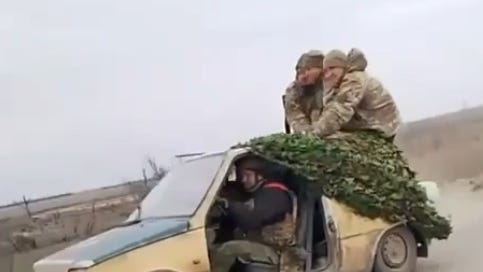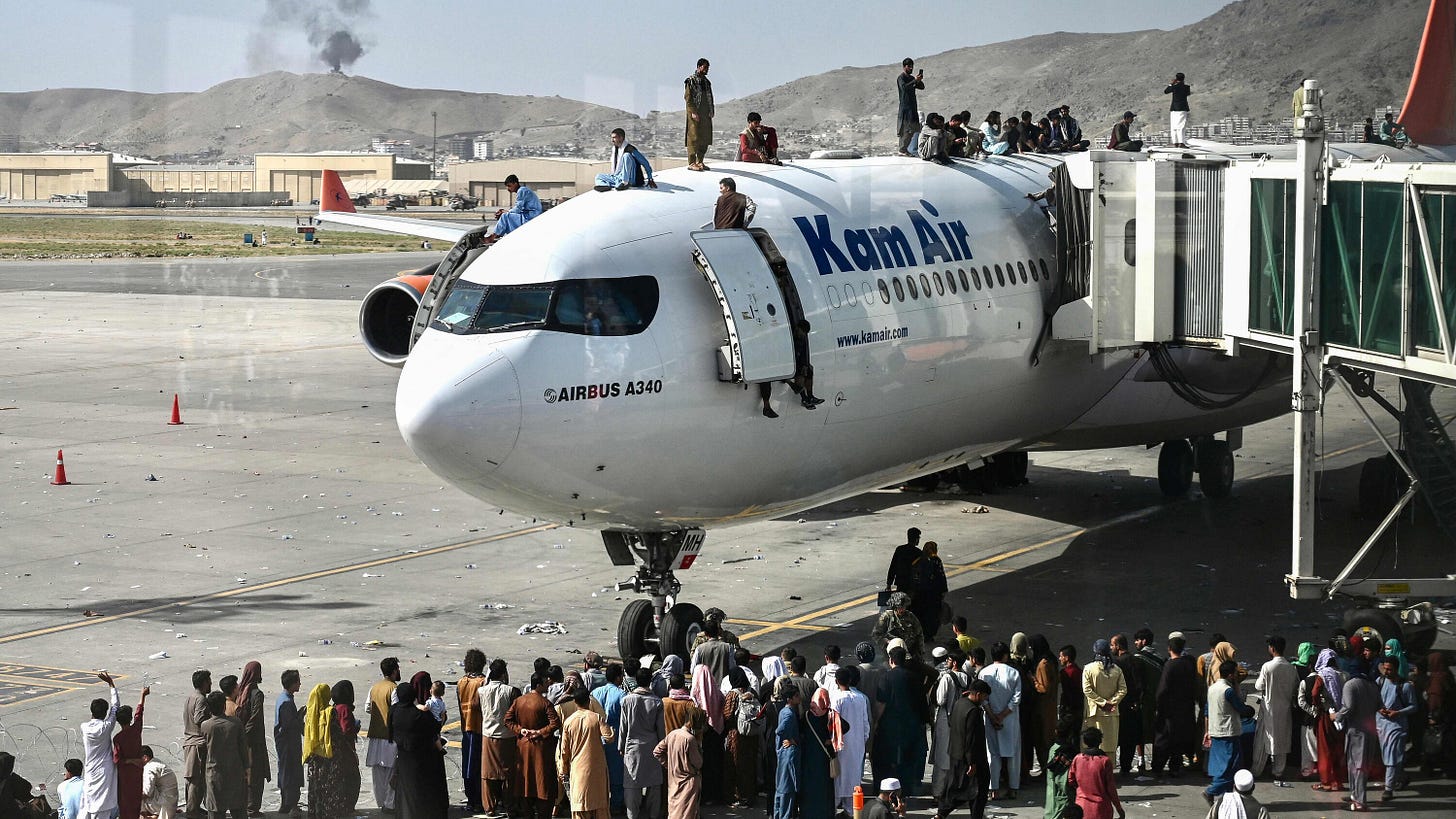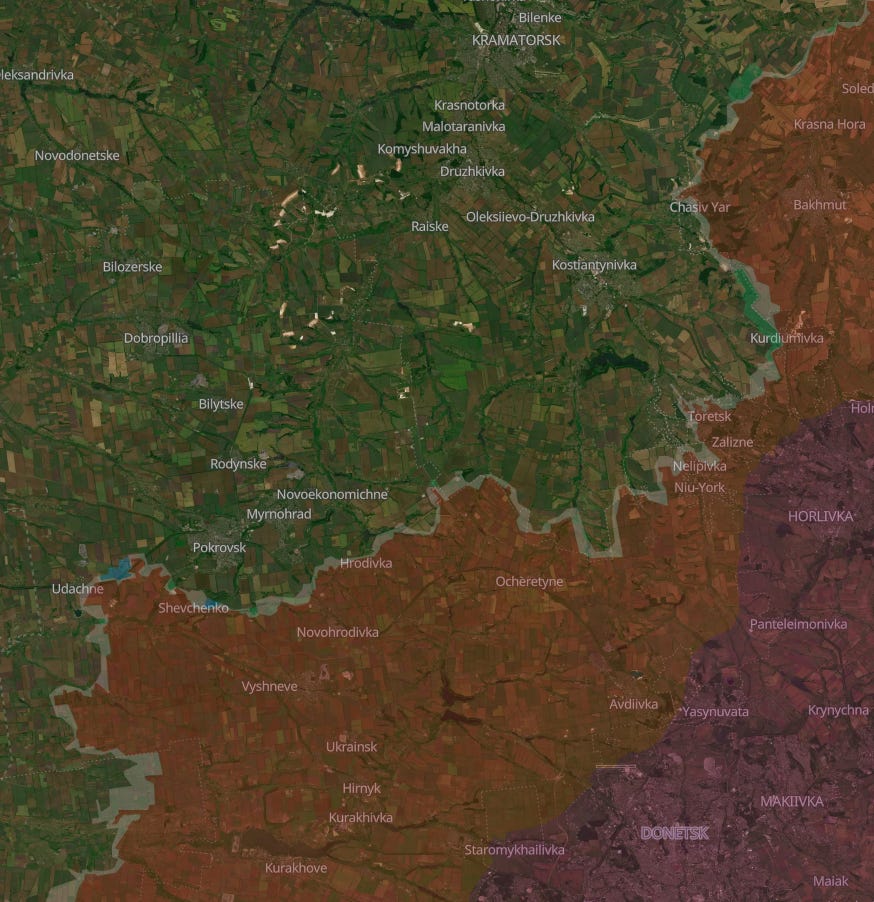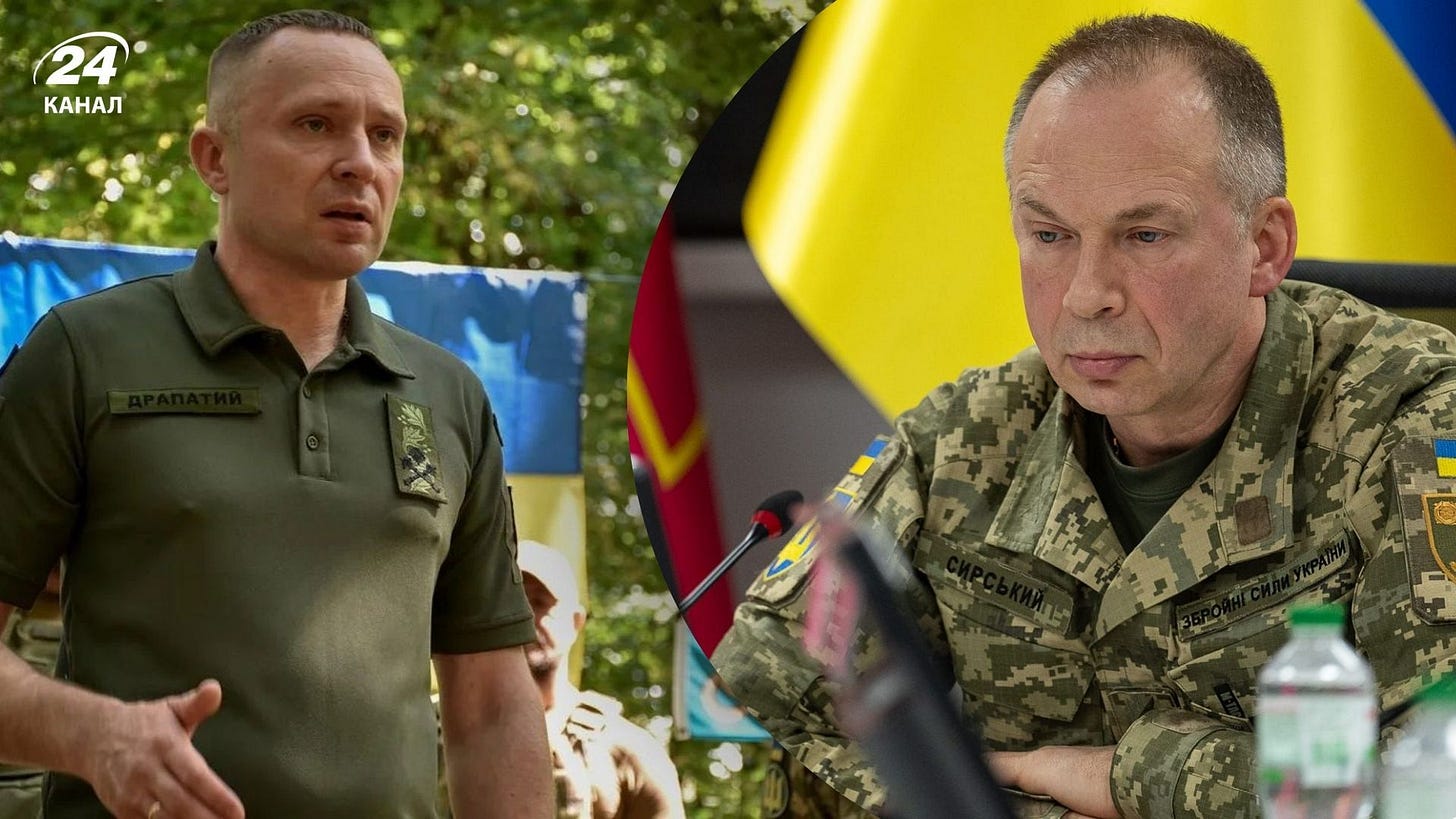April military update
Vietnamization, Afganization. Frontline motorcycles and drone nets. American friends at the frontlines.
Ukrainian media has been abuzz lately with the Vietnam parallels - hence my recent article on it. The message is clear, whether its from the (formerly) USAID-sponsored Ukrainska Pravda, or Zelensky loyalist MP Mariana Bezuhla. Ukraine is likened to south Vietnam as the vanguard of the free, western, capitalist world, opposed to the robotic communist hordes of north Vietnam. Ukraine must not repeat the mistake of south Vietnam, which accepted US withdrawal without fixed ‘security guarantees’ to come to its defense.

There are other parallels, of course. I was in Ukraine when Kabul fell, and my nationalist, pro-western family reacted with the predictable quiet unease. But there’s one thing that certainly isn’t shared between Kabul, Saigon, and Kyiv - the military factor.
Certainly, the Ukrainian army suffers from serious desertion levels. Corruption is endemic, and forcibly mobilized soldiers aren’t filled with enthusiasm by the torture and extortion they often face in their units.
Nevertheless, it isn’t particularly easy to desert. Drone warfare turns the entire area around the frontline into a killing zone, where any human life - including civilians - are ineluctably targeted. It’s near impossible to withdraw dead or injured because of this factor, let alone those raising the white flag. In any case, ignoring an easy kill is just a waste of a drone, which has a limited flight time. The vast majority of drone flights end in failure - why waste a rare chance to chalk up some wins with the higher ups?
I also have no doubt that attempts to turn to the opposing side are ruthlessly punished by drones commanded by former comrades. Besides all that, there is the fact that surrendered soldiers do not always face an easy fate once disarmed, to put it lightly.
Beyond that, the Ukrainian army seems qualitatively different to the forces commanded by either Saigon or Kabul. Unlike either of those countries, Ukraine’s army already existed as a massive institution for decades. The remains of the Soviet army that fell under Kiev’s control in 1991 are a force to be reckoned with.
Not only in terms of the firepower it commands, or whatever positive military ethos that suffuses it ranks. But rather, in the multitude of clannish, corrupt interests that make up the higher officer elite. They have built up a fortune over the decades, one dramatically increased by wartime.
While this class of older officers may have studied or even born in Russia - both are true in the case of current head of the army Oleksandr Syrsky - they would have far fewer opportunities for personal enrichment were they to switch sides. The Russian army already has its clans, ones with far more power and domestic connections. This, by the way, is also the reason why Ukraine’s oligarchs were never particularly keen on increased integration with or annexation by their northern neighbor.

Finally, Ukraine’s army has something that neither Kabul nor Saigon had - a growing class of younger, ideologically charged militarists. The Azov movement, which started out in 2014 as merely a few dozen blackshirts who engaged in streetfights with pro-Russian or anti-maidan activists, was elevated in March to the status of corps, one of the first in Ukraine. It is leading the charge to reform Ukraine’s army to NATO standards, opposing itself to the ‘old, corrupt, Soviet’ general elite.
Pumped full of western aid and training, Azov and affiliated nationalist units are the first choice for mobilized troops and those wishing to volunteer. They have a reputation, or at least constantly cultivate one, of caring for their personnel, in contrast to the ‘soviet generals’ who prioritize suicidal ‘meat storms’. The latest criticism of Syrsky by a top Azov figure in the Guardian is one such example, but they are constantly conducting such propaganda.
While Ukraine’s old officer clans still seem largely in charge, younger representatives of this class supported by Azov are rising up the ranks. One example is general Mykhailo Drapaty, who took control of Ukraine’s most important frontline section late last year. Ukrainian media and Azov-affiliated telegrams credit him with slowing the Russian advance over recent months, though clearly there are other factors at play.
Moving on from personnel, there are conflicting reports on the Ukrainian army’s military self-sufficiency. The Ukrainian government’s main narrative of late has been that the army depends mainly on drones, which are largely assembled in Ukraine. Hence, it won’t be impacted by the disappearance of US aid.
However, the status of drones is still ambiguous. Drones capture their kills on camera, unlike artillery, thereby overstating their battlefield importance. They are also assembled using Chinese parts. Zelensky has been trying to attract Trump’s favor of late by provoking China, which hardly seems like a wise idea in terms of military supplies. The latest news on this front сame on April 18, with Zelensky implementing sanctions against three Chinese companies - Beijing Aviation And Aerospace Xianghui Technology, Rui Jin Machinery and Zhongfu Shenying Carbon Fiber Xining. The Ukrainian president claimed that these companies are supplying Russia with gunpowder and artillery shells, as well as producing weapons on Russian territory.
Finally, no matter how effective drones may be in stopping enemy advances, they don’t enable one’s own offensive operations. Russian troops are moving forward using small infantry groups, with drones providing cover. The demographic disbalance, as well as Russia’s unique ability to provide its troops with massive financial incentives, means that Ukraine lacks the infantry resources to conduct large scale offensive operations.
Over the past three months, Ukraine has been pecking away at Russia’s salient in the Pokrovsk region and some other hotspots on the Donbass front. These attacks are generally conducted by the most battle-ready Azov/Azov-affiliated units. However, the gains have been tiny, and are often soon after retaken by Russia. The latter continues to take much more Ukrainian territory than it loses. The following maps from Ukrainian army-sponsored OSINT group DeepState compares February 20 to April 20. The blue shows areas retaken by Ukraine.
For all these reasons, a long war of attrition is more likely than a Kabul or Saigon style collapse. A collapse at some point is possible, but it doesn’t appear particularly close at the moment. Let’s have a look at what Ukrainian officers on telegram have been writing in recent weeks. Due to the Trump administration’s skepticism towards Ukrainian capabilities, they have been much more circumspect about Ukrainian weaknesses than under Biden. Nevertheless, interesting material can still be found. Among today’s topics:
Intrigues: struggles between top military clans and Azov’s rise
Drones and nets: Ukrainian-built nets covering key roads from drones fail due to corruption. Russian mass, state-sponsored drone production overcomes Ukrainian anarcho-capitalist drone supply chains
Motocross season: A range of entertaining videos of Russian infantrymen on motorcycles, and interesting analysis of the effectiveness of this tactic from Ukrainian military men.
Salaries, losses, and motivation: Complaints about reduced training time and low military salaries, ruminations on motivations, another fight between teenage civilians and soldiers in the capital.
American friends: A Ukrainian officer just back from training in the US reports that troops there are very supportive of Ukraine, as opposed to ‘degenerate’ Trump. Another Ukrainian military telegram reports on generous help from American friends - this time at the frontlines of Ukraine’s war. Read on to find out which strange American group he names.
Peace in May? As you might guess, the predictions aren’t pessimistic. Particularly notable is an Azov-affiliated telegram accusing the British of being interested in endless prolongation of the war.
Intrigues
Zelensky loyalist MP Mariana Bezuhla wrote a long post on April 11 accusing Syrsky of preventing the formation of a corps system in the army. She deploys her usual approach of blaming ‘corrupt Soviet generals’ for all failures at the frontline. Despite her populistic attempt to appeal to the nationalists, the latter despise her as a shrill civilian idiot.
❗️ For the second month now, the Commander-in-Chief has been blocking the transfer of brigades to the new corps, hindering the establishment of a corps system.
Syrskyi was opposed to transitioning the AFU [Armed Forces of Ukraine] to a corps system. He advocates for continuing the creation of new "paper" brigades and fragmenting units on the battlefield.
The staffing of corps headquarters is being formed primarily on a residual basis—using the worst, "excess" candidates assigned from brigades by top-down quotas, as well as "undesirables" sent into a kind of exile.
The corps structure is imposed from above without considering input from the brigades and with an inflated number of positions.
The Commander of Unmanned Systems Forces, Vadym Sukharevskyi, and several other "undesirable" leaders are also set to be exiled to the corps, removed from their positions, and stripped of decision-making authority. A so-called "drone directorate" is being formed within the General Staff—without any reform of the General Staff itself or purging it of "Soviet-era holdovers"—with the aim of diluting the role of the Unmanned Systems Forces and effectively attempting to dismantle its command.
The vast majority of personnel proposals by the Commander of the Ground Forces and head of the eastern front, Drapatyi, are being blocked. Meanwhile, Syrskyi constantly spreads whispers in circles that Drapatyi is allegedly engaged in politics rather than war, systematically fostering negative attitudes and irritation within the Presidential Office and the military. He is also doing everything possible to undermine and devalue the stabilization of the eastern front, which the new commander has managed to achieve.
At the same time, the mantra about the threat of a new full-scale offensive and the "indispensable" experience and skills of the current Commander-in-Chief is repeated—yet NOTHING is being done to systematically prepare for defense, reassess the front, or secure potentially vulnerable regions. I repeat, even the creation of corps is being artificially delayed! The fact that Russian forces have already crossed the border into Sumy Oblast is being downplayed and presented as a situation in the so-called "gray zone."
Beyond what I have long emphasized—that Syrskyi should never have been appointed to this position and should have been removed long ago, if not criminally prosecuted for his actions—I must note: keeping Drapatyi "on two chairs," both in logistics and combat, only destabilizes the system. Given his clear personal successes specifically in combat conditions, the question of appointing him responsible for the entire front, not just the eastern part, has long been overdue.
Perhaps if this decision had been made earlier, the Kursk fiasco could have been avoided.
P.S. In the National Guard, subordinate to the Ministry of Internal Affairs, they were given the freedom to adapt, and corps are already being actively formed—which further highlights the backwardness of AFU's leadership...
Her last sentence on the national guard refers to Azov. It is within the national guard that they have formed the ‘1st Azov Corps’. On the 15th, she praised the National Guard for forming two corps, naming Azov’s Denis Prokopenko as the leader of one of them. As usual, she contrasted this to the Syrsky’s ‘soviet-style’ corruption. Zelensky’s favored tactic of blaming all failures on the army continues.
Drones and nets
Onto the front. To begin with, the 46th brigade posted this video on April 5. Ukrainian troops have been clearly following suit after earlier Russian videos of the same strategy: drape a strategic road in nets to stop drones:
However, the nationalist Aidar batallion’s Stanislav Buniatov posted a video of how these nets were being overcome by Russian drones on April 17:
This is called 'Stole a meter, leave a meter gap'
A Russian optical drone flew through a corruption-made hole and hit a self-propelled artillery vehicle.
“Alex”/Officer warned his 174,000 followers about these nets on April 19:
Keep reading with a 7-day free trial
Subscribe to Events in Ukraine to keep reading this post and get 7 days of free access to the full post archives.









